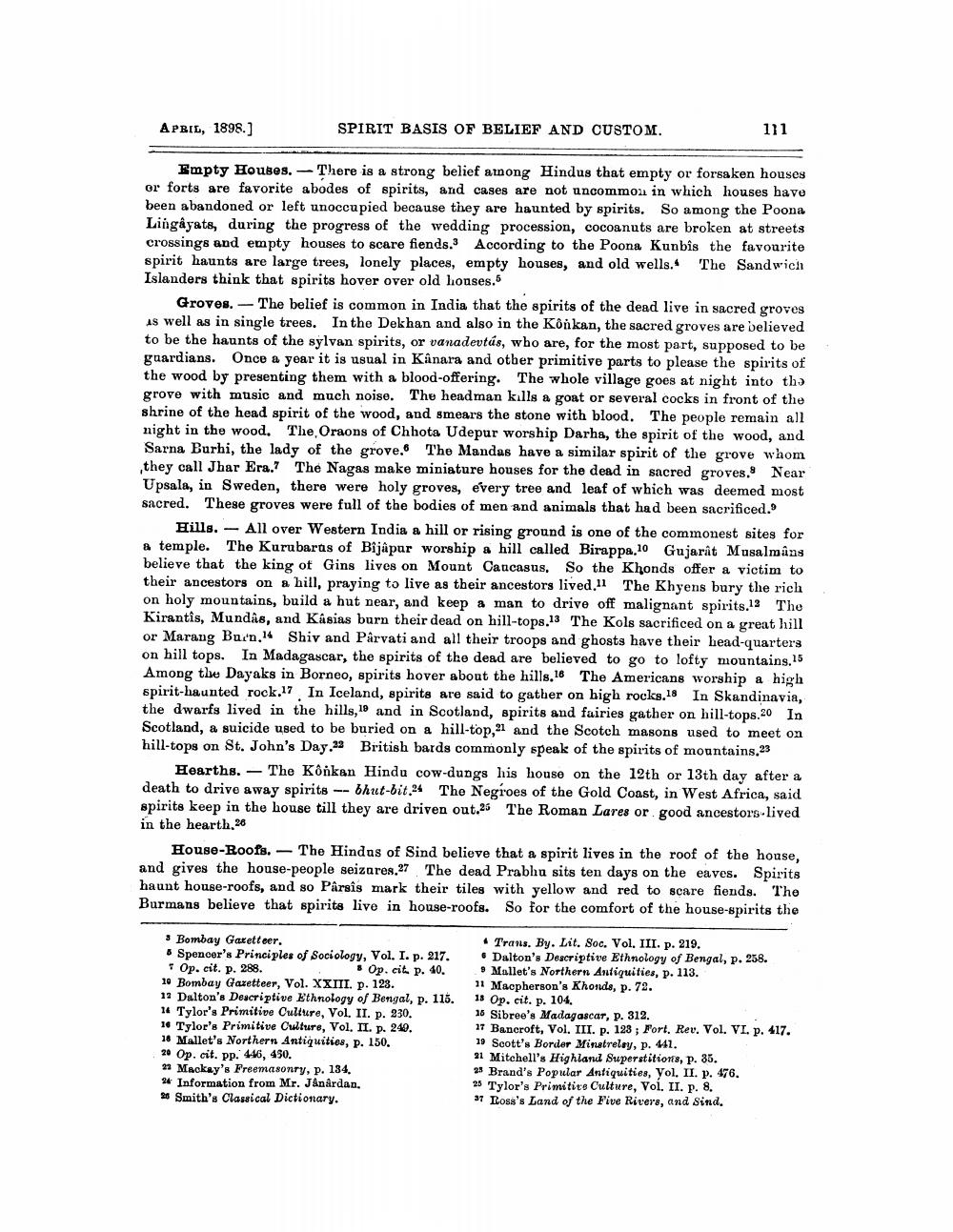________________
APBIL, 1898.)
SPIRIT BASIS OF BELIEF AND CUSTOM
111
Empty Houses. - There is a strong belief among Hindus that empty or forsaken houses or forts are favorite abodes of spirits, and cases are not uncommon in which houses have been abandoned or left unoccupied because they are haunted by spirits. So among the Poona Lingayats, during the progress of the wedding procession, cocoanuts are broken at streets crossings and empty houses to scare fiends. According to the Poona Kunbis the favourite spirit haunts are large trees, lonely places, empty houses, and old wells. The Sandwich Islanders think that spirits hover over old lionses.
Groves.- The belief is common in India that the spirits of the dead live in sacred groves as well as in single trees. In the Dekhan and also in the Kônkan, the sacred groves are believed to be the haunts of the sylvan spirits, or vanadevtás, who are, for the most part, supposed to be guardians. Once a year it is usual in Kinara and other primitive parts to please the spirits of the wood by presenting them with a blood-offering. The whole village goes at night into th> grove with music and much noise. The headman kills a goat or several cocks in front of the shrine of the head spirit of the wood, and smears the stone with blood. The people remain all night in the wood. The Oraons of Chhota Udepur worship Darha, the spirit of the wood, and Sarna Burhi, the lady of the grove. The Mandas have a similar spirit of the grove whom they call Jhar Era.7 The Nagas make miniature houses for the dead in sacred groves. Near Upsala, in Sweden, there were holy groves, every tree and leaf of which was deemed most sacred. These groves were full of the bodies of men and animals that had been sacrificed.
Hills. - All over Western India a hill or rising ground is one of the commonest sites for & temple. The Kurubarus of Bijapur worship a hill called Birappa.10 Gujarat Musalmans believe that the king of Gins lives on Mount Caucasus. So the Khonds offer a victim to their ancestors on a hill, praying to live as their ancestors lived.11 The Khyens bury the rich on holy mountains, build a hut near, and keep a man to drive off malignant spirits. The Kirantis, Mundís, and Käsias burn their dead on hill-tops,13 The Kols sacrificed on a great hill or Marang Burn. Shiv and Parvati and all their troops and ghosts have their head-quarters on hill tops. In Madagascar, the spirits of the dead are believed to go to lofty mountains.15 Among the Dayaks in Borneo, spirits hover about the hills.16 The Americans worship a high spirit-haunted rock.17 In Iceland, spirits are said to gather on high rocks.18 In Skandinavia, the dwarfs lived in the hills, 19 and in Scotland, spirits and fairies gather on hill-tops.20 In Scotland, a suicide used to be buried on a hill-top, 21 and the Scotch masons used to meet on hill-tops on St. John's Day 22 British bards commonly speak of the spirits of mountains.23
Hearths. - The Kônkan Hindu cow-dungs his house on the 12th or 13th day after a death to drive away spirits -- bhut-bit.24 The Negroes of the Gold Coast, in West Africa, said spirits keep in the house till they are driven out.26 The Roman Lares or good ancestors.lived in the hearth.26
House-Roofs. - The Hindus of Sind believe that a spirit lives in the roof of the house, and gives the house people seizares.27 The dead Prabha sits ten days on the eaves. Spirits haunt house-roofs, and so Parsis mark their tiles with yellow and red to scare fiends. The Burmans believe that spirits live in house-roofs. So for the comfort of the house-spirits the
• Bombay Gazetteer. 5 Spencer's Principles of Sociology, Vol. I. p. 217. Op. cit. p. 288.
Op.cit p. 40. 10 Bombay Gazetteer, Vol. XXIII. p. 123. 12 Dalton's Descriptive Ethnology of Bengal, p. 116. 14 Tylor's Primitive Culture, Vol. II. p. 230. 16 Tylor's Primitive Culture, Vol. II. p. 249. 16 Mallet's Northern Antiquities, p. 150. 20 Op. cit. pp. 446, 450.
Mackay's Freemasonry, p. 134. 2 Information from Mr. Jánardan, 25 Smith's Classical Dictionary.
• Trans. By. Lit. Soc. Vol. III. p. 219. • Dalton's Descriptive Ethnology of Bengal, p. 258. 9 Mallet's Northern Antiquities, p. 113. 11 Macpherson's Khonds, p. 72. 18 Op. cit. p. 104 15 Sibree's Madagascar, p. 312. 17 Bancroft, Vol. III. p. 123; Fort. Rev. Vol. VI. p. 417. 19 Scott's Border Minstrelay, p. 441. 21 Mitchell's Highland Superstitions, p. 35. 23 Brand's Popular Antiquities, Yol. II. p. 476. 25 Tylor's Primitits Culture, Vol. II. p. 8. 37 Loss's Land of the Five Rivers, and Sind.




